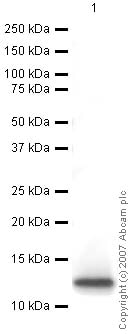Anti-CXCL14 antibody (ab36622)
Key features and details
- Rabbit polyclonal to CXCL14
- Suitable for: WB
- Reacts with: Human
- Isotype: IgG
Overview
-
Product name
Anti-CXCL14 antibody
See all CXCL14 primary antibodies -
Description
Rabbit polyclonal to CXCL14 -
Host species
Rabbit -
Tested Applications & Species
See all applications and species dataApplication Species WB Human -
Immunogen
Synthetic peptide corresponding to Human CXCL14 aa 1-100 conjugated to keyhole limpet haemocyanin.
(Peptide available asab36621)
Properties
-
Form
Liquid -
Storage instructions
Shipped at 4°C. Store at +4°C short term (1-2 weeks). Upon delivery aliquot. Store at -20°C or -80°C. Avoid freeze / thaw cycle. -
Storage buffer
pH: 7.40
Preservative: 0.02% Sodium azide
Constituent: PBS
Batches of this product that have a concentration Concentration information loading...
Concentration information loading...Purity
Immunogen affinity purifiedClonality
PolyclonalIsotype
IgGResearch areas
Associated products
-
Compatible Secondaries
-
Isotype control
-
Positive Controls
-
Recombinant Protein
Applications
The Abpromise guarantee
Our Abpromise guarantee covers the use of ab36622 in the following tested applications.
The application notes include recommended starting dilutions; optimal dilutions/concentrations should be determined by the end user.
GuaranteedTested applications are guaranteed to work and covered by our Abpromise guarantee.
PredictedPredicted to work for this combination of applications and species but not guaranteed.
IncompatibleDoes not work for this combination of applications and species.
Application Species WB HumanAll applications RatCowPigApplication Abreviews Notes WB Use a concentration of 1 µg/ml. Detects a band of approximately 12 kDa (predicted molecular weight: 12 kDa).Notes WB
Use a concentration of 1 µg/ml. Detects a band of approximately 12 kDa (predicted molecular weight: 12 kDa).Target
-
Function
Potent chemoattractant for neutrophils, and weaker for dendritic cells. Not chemotactive for T-cells, B-cells, monocytes, natural killer cells or granulocytes. Does not inhibit proliferation of myeloid progenitors in colony formation assays. -
Tissue specificity
Expressed in heart, brain, placenta, lung, liver, skeletal muscle, kidney and pancreas. Highly expressed in normal tissue without inflammatory stimuli and infrequently expressed in cancer cell lines. Weakly expressed in monocyte-derived dendritic cells. Not detected in lung or unstimulated peripheral blood lymphocytes. -
Sequence similarities
Belongs to the intercrine alpha (chemokine CxC) family. -
Cellular localization
Secreted. - Information by UniProt
-
Database links
- Entrez Gene: 511771 Cow
- Entrez Gene: 9547 Human
- Entrez Gene: 494467 Pig
- Entrez Gene: 306748 Rat
- Omim: 604186 Human
- SwissProt: O95715 Human
- Unigene: 483444 Human
-
Alternative names
- 1110031L23Rik antibody
- 1200006I23Rik antibody
- AI414372 antibody
see all
Images
-
Anti-CXCL14 antibody (ab36622) at 1 µg/ml + Human Cxcl14/BRAK recombinant protein at 0.1 µg
Secondary
IRDye 680 Conjugated Goat Anti-Rabbit IgG (H+L) at 1/10000 dilution
Performed under reducing conditions.
Predicted band size: 12 kDa
Observed band size: 12 kDa
Datasheets and documents
References (3)
ab36622 has been referenced in 3 publications.
- Takahashi R et al. Defining Transcriptional Signatures of Human Hair Follicle Cell States. J Invest Dermatol 140:764-773.e4 (2020). PubMed: 31676413
- Schüler-Toprak S et al. Agonists and knockdown of estrogen receptor ß differentially affect invasion of triple-negative breast cancer cells in vitro. BMC Cancer 16:951 (2016). PubMed: 28003019
- Strong JA et al. Microarray analysis of rat sensory ganglia after local inflammation implicates novel cytokines in pain. PLoS One 7:e40779 (2012). IHC-FoFr ; Rat . PubMed: 22815815
Images
-
Anti-CXCL14 antibody (ab36622) at 1 µg/ml + Human Cxcl14/BRAK recombinant protein at 0.1 µg
Secondary
IRDye 680 Conjugated Goat Anti-Rabbit IgG (H+L) at 1/10000 dilution
Performed under reducing conditions.
Predicted band size: 12 kDa
Observed band size: 12 kDa
-
















